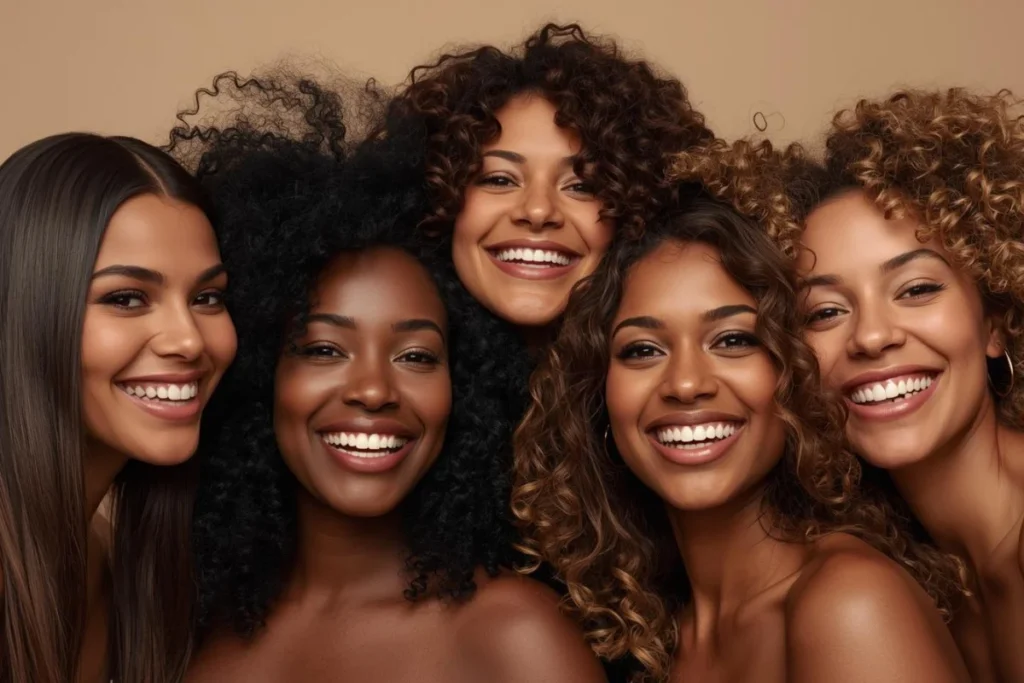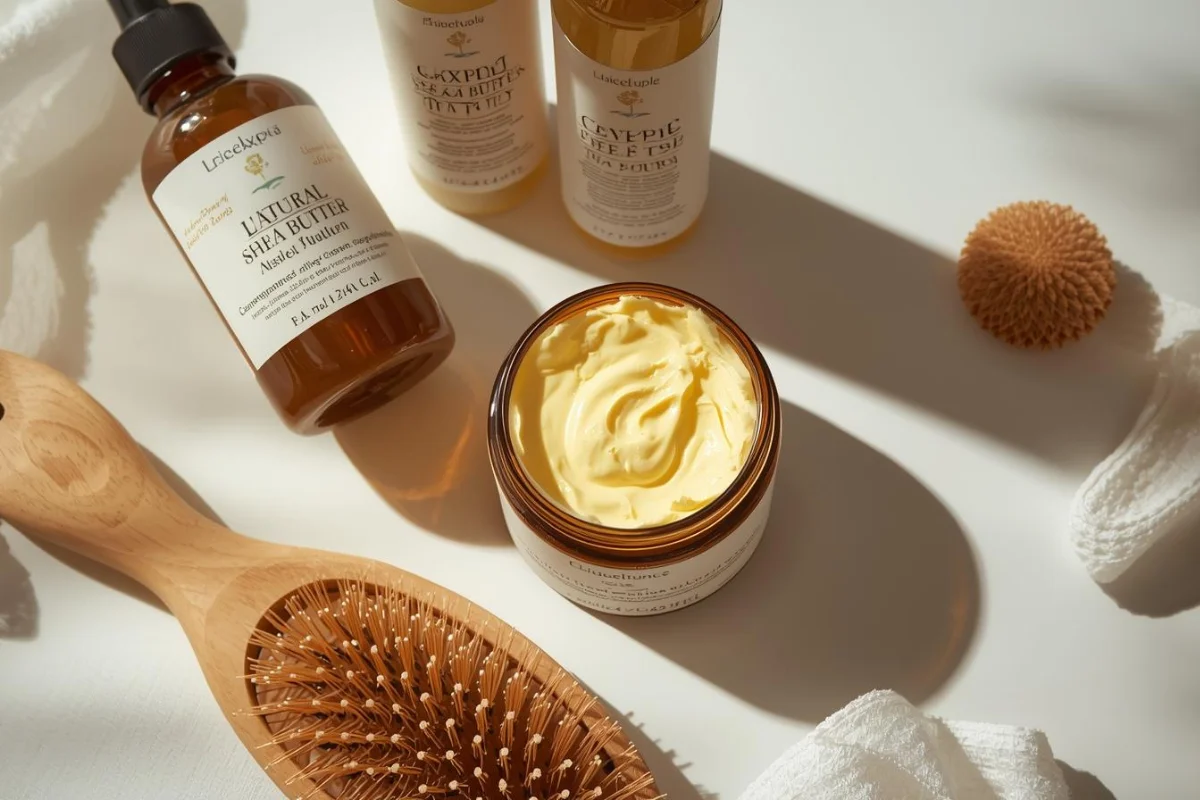Shea butter has been called “liquid gold” for the skin — but when it comes to your hair, it’s nothing short of a miracle ingredient. Whether you have curly, coily, straight, or chemically treated hair, shea butter can deeply nourish, protect, and transform your strands in ways few natural ingredients can.
In this comprehensive guide, I’ll walk you through why shea butter is good for hair, the science behind its moisturizing power, and how different hair types — from 1A to 4C — can benefit from it. I’ll also share my expert insight as a beauty product specialist on choosing the right type of shea butter and combining it with other ingredients for maximum hair health and growth.
What Is Shea Butter and Why It’s a Game-Changer for Hair
Shea butter is extracted from the nuts of the African shea tree (Vitellaria paradoxa). It’s rich in vitamins A, E, and F, as well as essential fatty acids like oleic, stearic, and linoleic acid — all of which make it an exceptional emollient and protectant.
When applied to the hair, these natural oils:
- Seal in moisture and reduce water loss.
- Protect against heat and UV damage.
- Soothe dry, flaky scalps and calm inflammation.
- Strengthen the hair shaft and reduce breakage.
This is why traditional African communities have used shea butter for centuries to maintain healthy, resilient hair — even in harsh climates.

Key Shea Butter Benefits for Hair
Let’s break down the top benefits you can expect from regular shea butter use:
a) Deep Moisturization
Shea butter penetrates the cuticle and locks in moisture, making it ideal for dry, coarse, or brittle hair. Its fatty acids mimic the natural oils produced by your scalp, preventing dehydration.
b) Protection from Heat and Chemicals
If you use flat irons, blow-dryers, or chemical relaxers, shea butter forms a thin, protective layer that shields your hair from damage.
c) Promotes Hair Growth
By reducing scalp inflammation, improving circulation, and strengthening the follicles, shea butter creates a healthy environment for hair growth. It also helps reduce breakage, so your hair retains length more easily.
d) Reduces Dandruff and Scalp Irritation
Thanks to its anti-inflammatory and antifungal properties, shea butter helps soothe scalp conditions like dandruff, psoriasis, and eczema.
e) Restores Shine and Elasticity
The natural oils and vitamins replenish lost luster and improve the elasticity of damaged strands, preventing split ends and tangling.
Raw vs. Refined Shea Butter: Which Is Better for Hair?
Not all shea butter is created equal.
- Raw (Unrefined) Shea Butter:
Beige or yellowish in color, retains all its natural nutrients. Best for natural hair care and scalp treatments. - Refined Shea Butter:
White, odorless, and smoother — but may lose some vitamins and antioxidants during processing.
For hair care, I always recommend raw or cold-pressed shea butter to maximize its nourishing potential.
Is Shea Butter Good for Hair Growth?
Yes — and here’s why.
Hair growth depends on two main factors: a healthy scalp and strong hair follicles. Shea butter targets both.
It contains vitamin E, which improves blood circulation to the scalp and supports follicle regeneration. Its anti-inflammatory properties calm irritation that could block hair growth, while vitamin A encourages sebum balance — essential for healthy roots.
When massaged into the scalp, raw shea butter helps unclog hair follicles and stimulate new growth naturally.

Shea Butter for Different Hair Types (1A to 4C)
Every hair type reacts differently to oils and butters. Let’s explore how shea butter works for each texture:
Type 1 (Straight Hair)
- Use sparingly as a leave-in or mask — too much may weigh your hair down.
- Combine with lighter oils (e.g., argan or jojoba).
Type 2 (Wavy Hair)
- Apply a tiny amount to damp hair for frizz control.
- Works great as a protective coating before heat styling.
Type 3 (Curly Hair)
- Shea butter defines curls, enhances bounce, and minimizes frizz.
- Ideal in curl creams or shea butter hair masks.
Type 4 (Coily or Kinky Hair)
- A holy-grail moisturizer for 4A, 4B, and 4C textures.
- Locks in hydration and softens even the driest coils.
- Try whipped shea butter blends for easy detangling.
Shea Butter for Color-Treated and Chemically Processed Hair
Is shea butter good for dyed, permed, or relaxed hair? Absolutely.
Color and chemical treatments strip away the natural oils in your hair. Shea butter replenishes these lost lipids and strengthens the cortex, making hair less prone to breakage and fading.
If you bleach or dye your hair, a weekly shea butter mask can drastically improve resilience and shine.
Shea Moisture and Cantu Shea Butter: Brand Insights
Many readers ask me whether SheaMoisture or Cantu products are good for their hair types. Here’s what you should know:
- SheaMoisture:
Excellent for natural, curly, or coily hair. Contains raw shea butter, coconut oil, and Jamaican black castor oil — perfect for repair and growth.
Best for: 3B–4C hair, dry or damaged hair, and hair growth routines. - Cantu Shea Butter:
Lighter formulas that blend shea with argan and jojoba oils.
Best for: Wavy, fine, or chemically processed hair that needs moisture without heaviness.

How to Use Shea Butter for Hair
1. As a Leave-In Conditioner
Rub a small amount between your palms until melted, then apply to damp hair, focusing on the ends.
2. As a Deep-Conditioning Mask
Mix shea butter with coconut oil and honey. Apply to your hair for 30–45 minutes under a shower cap, then rinse.
3. As a Scalp Treatment
Massage warm shea butter directly into your scalp to reduce dryness, dandruff, and irritation.
4. As a Heat Protectant
Melt a pea-sized amount, distribute evenly through hair before blow-drying or straightening.
Shea Butter for Wigs, Extensions, and Beards
- Human Hair Wigs: Shea butter restores shine and softness without leaving residue.
- Hair Extensions: Prevents frizz and tangling — especially synthetic blends.
- Beard Hair: Softens coarse beard texture and prevents flaking under the skin.
Lesser-Known Uses and Combinations
- Mango or Cocoa Shea Blends: Add extra vitamins and scent for dry or brittle hair.
- Whipped Shea Butter: Easier to apply, absorbs faster.
- Shea Butter + Essential Oils (Tea Tree, Peppermint): Great for itchy scalps.
- Shea Butter + Aloe Vera Gel: Combats dryness and adds shine.
Common Mistakes to Avoid
- Using too much — a little goes a long way.
- Applying to dirty or product-heavy hair (can cause buildup).
- Buying bleached or low-quality butter without nutrients.
- Storing in warm environments (melts and loses texture).
Final Thoughts: Why Shea Butter Deserves a Place in Your Hair Routine
After two decades working with natural hair care formulations, I can confidently say that shea butter is one of the most effective natural ingredients for restoring moisture, shine, and strength to any hair type.
It bridges the gap between hydration and protection, making it invaluable for curly, coily, and color-treated hair alike. Whether you choose a pure unrefined butter or a trusted brand like SheaMoisture, integrating shea butter into your weekly routine can completely transform your hair’s health.
Expert Endorsement
This guide was written by Prof. Dr. Thomson Meier, Board-Certified Trichologist (Hair & Scalp Science). In our professional experience, these insights reflect best practices validated by real-world use.
Specialized in hair fiber biology, scalp inflammation, and cosmetic trichology with over 15 years of clinical and formulation experience.
Questions for the author or reviewer? thomsonmeier@elizabethbeautyproducts.com

